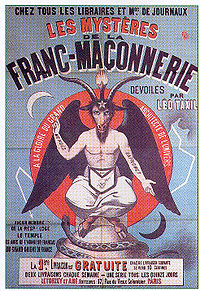- Taxil hoax
-
The Taxil hoax was an 1890s hoax of exposure by Léo Taxil intended to mock not only Freemasonry, but also the Roman Catholic Church's opposition to it.[1]
Contents
Taxil and Freemasonry
Léo Taxil was the pen name of Marie Joseph Gabriel Antoine Jogand-Pagès, who had been accused earlier of libel regarding a book he wrote called The Secret Loves of Pope Pius IX. On April 20, 1884 Pope Leo XIII published an encyclical, Humanum Genus, that said that the human race was
"separated into two diverse and opposite parts, of which the one steadfastly contends for truth and virtue, the other of those things which are contrary to virtue and to truth. The one is the kingdom of God on earth, namely, the true Church of Jesus Christ... The other is the kingdom of Satan..."
This kingdom was said to be "led on or assisted" by Freemasonry.
After this encyclical, Taxil underwent a public, feigned conversion to Roman Catholicism, and announced his intention of repairing the damage he had done to the true faith.
The first book produced by Taxil after his conversion was a four-volume history of Freemasonry, which contained fictitious eyewitness verifications of their participation in Satanism. With a collaborator who published as "Dr. Karl Hacks," Taxil wrote another book called the Devil in the Nineteenth Century, which introduced a new character, Diana Vaughan, a supposed descendant of the Rosicrucian alchemist Thomas Vaughan. The book contained many implausible tales about her encounters with incarnate demons, one of whom was supposed to have written prophecies on her back with its tail, and another who played the piano in the shape of a crocodile.[2]
Diana was supposedly involved in Satanic freemasonry, but was redeemed when one day she professed admiration for Joan of Arc, at whose name the demons were put to flight. As Diana Vaughan, Taxil published a book called Eucharistic Novena, a collection of prayers which were praised by the Pope.
On April 19, 1897 Taxil called a press conference at which he claimed he would introduce Diana Vaughan to the press. He instead announced that many of his revelations about the Freemasons were fictitious. He thanked the clergy for their assistance in giving publicity to his wild claims.[3][broken citation][citation needed]
The hoax material is still used to this day. Chick Publications publishes such a tract called The Curse of Baphomet and Randy Noblitt's book on satanic ritual abuse, Cult and Ritual Abuse also cites the Taxil hoax.[4]
The Luciferian Quote
The quote most frequently associated with the Taxil Hoax reads:
That which we must say to the world is that we worship a god, but it is the god that one adores without superstition. To you, Sovereign Grand Inspectors General, we say this, that you may repeat it to the brethren of the 32nd, 31st and 30th degrees: The masonic Religion should be, by all of us initiates of the higher degrees, maintained in the Purity of the Luciferian doctrine. If Lucifer were not God, would Adonay and his priests calumniate him?
Yes, Lucifer is God, and unfortunately Adonay is also god. For the eternal law is that there is no light without shade, no beauty without ugliness, no white without black, for the absolute can only exist as two gods; darkness being necessary for light to serve as its foil as the pedestal is necessary to the statue, and the brake to the locomotive....
Thus, the doctrine of Satanism is a heresy, and the true and pure philosophical religion is the belief in Lucifer, the equal of Adonay; but Lucifer, God of Light and God of Good, is struggling for humanity against Adonay, the God of Darkness and Evil.
While this quote was published by Abel Clarin de la Rive in his Woman and Child in Universal Freemasonry, and does not appear in Taxil's writings proper, it is sourced in a footnote to Diana Vaughan, Taxil's creation.[5]
References
- ^ "Mysteries Of The Freemasons — America". written by Noah Nicholas and Molly Bedell. Decoding the Past. A&E Television Networks. The History Channel. 2006-08-01.
- ^ Hause, Steven C. (Spring89). "Anti – Protestant Rhetoric in the Early Third Republic". French Historical Studies 16 (1): 192.
- ^ "The Confession of Leo Taxil". April 25, 1897. http://altreligion.about.com/library/texts/bl_confessiontaxil.htm. Retrieved 2007-10-25.
- ^ King, EL. "Book review: Cult & Ritual Abuse — Its History, Anthropology, and Recent Discovery in Contemporary America". http://www.masonicinfo.com/books/cultritualabuse.htm. Retrieved 2009-04-05.
- ^ de Hoyos, Arturo; Morris, S. Brent (1998). "Albert Pike and Lucifer". Is It True What They Say About Freemasonry? (2nd edition (revised) ed.). Silver Spring, Maryland: Masonic Information Center. http://www.srmason-sj.org/web/SRpublications/DeHoyos.htm#i11. Retrieved 2007-10-25.
Further reading
- Melior, Alec (1961). "A Hoaxer of Genius-Leo Taxil (1890-7)". Our Separated Brethren, the Freemasons. trans. B. R. Feinson. London: G. G. Harrap & Co.. pp. 149–55.
External links
- "A hoax", l'Illustration, May 1. 1897- No. 2827: Paris, France.
- Abel Claren de la Rive (1855-1914)
- Devil-Worship in France, by A.E. Waite complete e-text of Waite's debunking of Taxil.
- Lady Queenborough, Edith Starr Miller
- Leo Taxil's Confession
Categories:- Catholicism and Freemasonry
- History of Freemasonry
- Freemasonry in France
- Satanism
- Hoaxes in France
- 19th-century hoaxes
Wikimedia Foundation. 2010.


